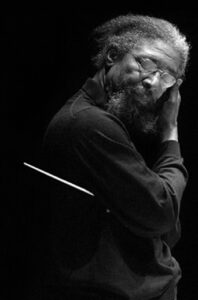
conduction.us
Primary Scene: New York
Lawrence D. “Butch” Morris is recognized internationally as the principal theorist and practitioner in the evolution of CONDUCTION®, and a leading innovator in the confluence of jazz, new music, improvisation and contemporary classical music. Mr. Morris’s work redefines the roles of composer, conductor, arranger and performer, and bridges the gap between the composer, interpreter and improviser.
Since 1974, his career has been distinguished by unique and outstanding international contributions to television, film, theater, dance, radio, interdisciplinary collaborations, concerts and recordings, and he leads Conduction® Workshops world-
Music began in the home, a constant presence, both played and appreciated. And as it was for him, so for his siblings. His eldest and youngest brothers, Joe and Michael, took up the clarinet, his sister, Marceline, studied piano, and his other brother, the late Wilber Morris (1937-
By his fourteenth year, “Butch” owned a trumpet, and his early path with brass was set. He studied music theory, harmony and composition throughout public school while playing in the school marching and studio bands, and orchestra. During this time, Morris also taught himself to play French horn, flute, trombone, baritone-
After graduating, Morris enhanced his musical abilities. He often sat-
In 1966, Morris’ life took a decisive turn. Conscripted into the U.S. army as a clerk typist, he served as a truck driver in Germany, a medic Vietnam, a patient in Japan and a postal clerk in Okinawa. “I used to practice the horn and write music in an ambulance,” he wrote, “It’s where I first started to think about music from a completely different perspective.”
With his tour of duty over, Morris studied prosthetics and orthotics, toward a career in health science. But all that changed when he encountered the vibrant Los Angeles “new jazz scene” of the 1960s. Through his brother Wilber he met Arthur Blythe, Bobby Bradford, John Carter and pianist Horace Tapscott’s “Pan African Peoples Arkestra,” the leading community for innovative musicians. Morris then joined with David Murray, James Newton, Diamanda Galas, and Mark Dresser. While working with master trumpet maker Dominic Callicchio, Morris also discovered that the cornet possessed the sound he was seeking.
Led north by his inspiration, Morris moved to the Bay Area of San Francisco for its exemplary musical and literary scenes, meeting musicians Charles Moffett, Charles Tyler, Frank Lowe, Ray Anderson, Curtis Clark, Keshavan Maslak, and writer Ntozake Shange. He also studied Cornet and composition with Little Benny Harris (composer of the Jazz standard “Ornithology”) and conducting with Jackie Hairston.
Morris’ first interest in Conduction® stems from this period. He credits drummer Charles Moffett with exposing him to the possibilities of “conducted improvisation”. As Morris has put it: “My conducting teacher told me what couldn’t be done [to composed/notated music]. Charles Moffett taught me what could be done [despite traditions to the contrary].”
In 1976, Morris went east to New York City, where several collaborators had established themselves, reuniting with Charles Tyler, Frank Lowe and David Murray. That fall, Morris and Lowe toured Europe, introducing Morris to an international milieu that marks him to this day. He settled in Paris then the South of France, and taught workshops in Holland and in Belgium at the Conservatory Royal, Liege (under the directorship of Henri Pousseur), played with “Philly” Joe Jones, Steve Lacy and Gil Evans all the while exploring his then new method for ensemble creation, Conduction®.
New York was there as well, and Morris often returned to collaborate with writers, visual artists, dancers and musicians on multi-
The Conduction® performance chronology begins in 1985, and continues to the present. Through it, he has engaged an astonishing number and variety of musicians from different cultures and traditions. He defines it this way:
“Conduction®: The practice of conveying and interpreting a lexicon of directives to modify or construct sonic arrangement or composition; a structure-
Between 1985 and 2011, Morris has created and produced over 200 Conductions worldwide, refining with each performance this unique musical concept. His numerous recordings and projects express a range of accomplishment that distinguishes him, then as now. It encompasses improvisatory and interpretive musical cultures –
His is a world of synthesis whose music and performance contributions will help to sustain the health, longevity, and creativity of music, culture, and the arts in this, our 21st century.
Morris passed away on January 29, 2013 in Brooklyn, New York.
Morris, Butch